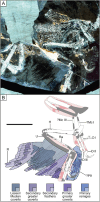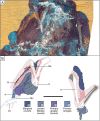Forelimb feathering, soft tissues, and skeleton of the flying dromaeosaurid Microraptor
- PMID: 40597592
- PMCID: PMC12211143
- DOI: 10.1186/s12862-025-02397-5
Forelimb feathering, soft tissues, and skeleton of the flying dromaeosaurid Microraptor
Abstract
Background: Microraptor is an essential animal for understanding the evolution of flight in birds and their closest relatives. Recent studies have uncovered evidence of its powered flight potential and details of its diet and ecology. However, we are still missing a thorough description of the anatomy of Microraptor connecting feathers, soft tissues, and osteology together. Here we focus on the forelimbs of ten new Microraptor specimens from the Shandong Tianyu Museum of Nature studied under Laser-Stimulated Fluorescence. We compared our results with extensively studied existing specimens (e.g., IVPP V13352 and BMNHC PH881), other key early paravians (e.g., Anchiornis, Archaeopteryx and Confuciusornis), as well as modern birds to expand what we know about flight origins, and early diverging paravian theropods more generally.
Results: Plumage was previously only minimally known. Reconstruction of the forewings relied on brief descriptions of the primary and secondary feathers. With the new specimens studied here, we uncovered the whole shape of the wing from the tip of the digits to the proximal end of the ulna, the different layers of feathers, and the number as well as characteristics of each feather type. Skeletal features of the forelimb remain mostly unchanged from previous descriptions, but we bring new information regarding wrist bones and functional implications of humerus and radius features. The most significant advances have been recovered in preserved soft tissues including those of the shoulder, propatagium and postpatagium. In particular, the new specimens of Microraptor help us to understand the impact of the soft tissues on lift generation and cohesiveness of the forewing.
Conclusions: This study permitted us to recreate the most accurate forewing of Microraptor to date. Taken together, new information on the forelimb anatomy shows that Microraptor shares many of the forewing characteristics of early avialans and modern birds, and helps us to better understand the flight behaviour and ecology of this iconic and unique 'four-winged' animal along with its role in flight evolution. These results serve as a starting point to conduct more precise and integrative analyses (e.g., including hindwings and/or tail) on the locomotor behaviours of Microraptor.
Keywords: Microraptor; Feathered dinosaur; Feathering; Flight anatomy; Flight evolution; Forelimb; Theropod; Wing.
© 2025. The Author(s).
Conflict of interest statement
Declarations. Ethics approval and consent to participate: Not applicable. Consent for publication: Not applicable. Competing interests: Michael Pittman, T. Alexander Dececchi & Michael B. Habib are guest editors for the Vertebrate Flight Evolution collection and should not be considered for editorial duties for this manuscript. No other authors declare competing interest.
Figures










Similar articles
-
New information on the Hind limb feathering, soft tissues and skeleton of Microraptor (Theropoda: Dromaeosauridae).BMC Ecol Evol. 2025 Apr 24;25(1):37. doi: 10.1186/s12862-025-02372-0. BMC Ecol Evol. 2025. PMID: 40275136 Free PMC article.
-
Reorganization of the theropod wrist preceded the origin of avian flight.Nature. 2025 Aug;644(8077):699-705. doi: 10.1038/s41586-025-09232-3. Epub 2025 Jul 9. Nature. 2025. PMID: 40634603
-
Earliest evidence of avian primary feather moult.Biol Lett. 2024 Jun;20(7):20240106. doi: 10.1098/rsbl.2024.0106. Epub 2024 Jul 3. Biol Lett. 2024. PMID: 38955226 Free PMC article.
-
Insights into the early evolution of modern avian physiology from fossilized soft tissues from the Mesozoic.Philos Trans R Soc Lond B Biol Sci. 2025 Feb 27;380(1920):20230426. doi: 10.1098/rstb.2023.0426. Epub 2025 Feb 27. Philos Trans R Soc Lond B Biol Sci. 2025. PMID: 40010392 Review.
-
Measures implemented in the school setting to contain the COVID-19 pandemic.Cochrane Database Syst Rev. 2022 Jan 17;1(1):CD015029. doi: 10.1002/14651858.CD015029. Cochrane Database Syst Rev. 2022. Update in: Cochrane Database Syst Rev. 2024 May 2;5:CD015029. doi: 10.1002/14651858.CD015029.pub2. PMID: 35037252 Free PMC article. Updated.
References
-
- Norberg UM. Flying, gliding, and soaring. Functional vertebrate morphology. Cambridge: Harvard University Press; 2013. pp. 129–58.
-
- Longrich NR, Vinther J, Meng QJ, Li QG, Russell AP. Primitive wing feather arrangement in Archaeopteryx lithographica and Anchiornis huxleyi. Curr Biol. 2012;22(23):2262–7. - PubMed
-
- Saitta ET, Gelernter R, Vinther J. Additional information on the primitive contour and wing feathering of paravian dinosaurs. Palaeontology. 2018;61(2):273–88.
-
- Lefèvre U, Cau A, Hu D, Godefroit P. Feather evolution in Pennaraptora. In: Foth C, Rauhut OWM, editors. The evolution of feathers: from their origin to the present. Cham: Springer International Publishing; 2020. p. 103–18.
MeSH terms
Grants and funding
- 17120920; 17103315; 14116623; 14113824/Research Grants Council, University Grants Committee
- 17120920; 17103315; 14116623; 14113824/Research Grants Council, University Grants Committee
- 17120920; 17103315; 14116623; 14113824/Research Grants Council, University Grants Committee
- 17120920; 17103315; 14116623; 14113824/Research Grants Council, University Grants Committee
- 17120920; 17103315; 14116623; 14113824/Research Grants Council, University Grants Committee
- 17120920; 17103315; 14116623; 14113824/Research Grants Council, University Grants Committee
- 17120920; 17103315; 14116623; 14113824/Research Grants Council, University Grants Committee
- Postgraduate Scholarship/Chinese University of Hong Kong
- Postgraduate Scholarship/Chinese University of Hong Kong
- Ts20190954/Taishan Scholar Foundation of Shandong Province
- Ts20190954/Taishan Scholar Foundation of Shandong Province
- 42288201/National Natural Science Foundation of China
- 42288201/National Natural Science Foundation of China
- 42288201/National Natural Science Foundation of China
- 202305AB350006/Yunnan Revitalization Talent Support Program
LinkOut - more resources
Full Text Sources
